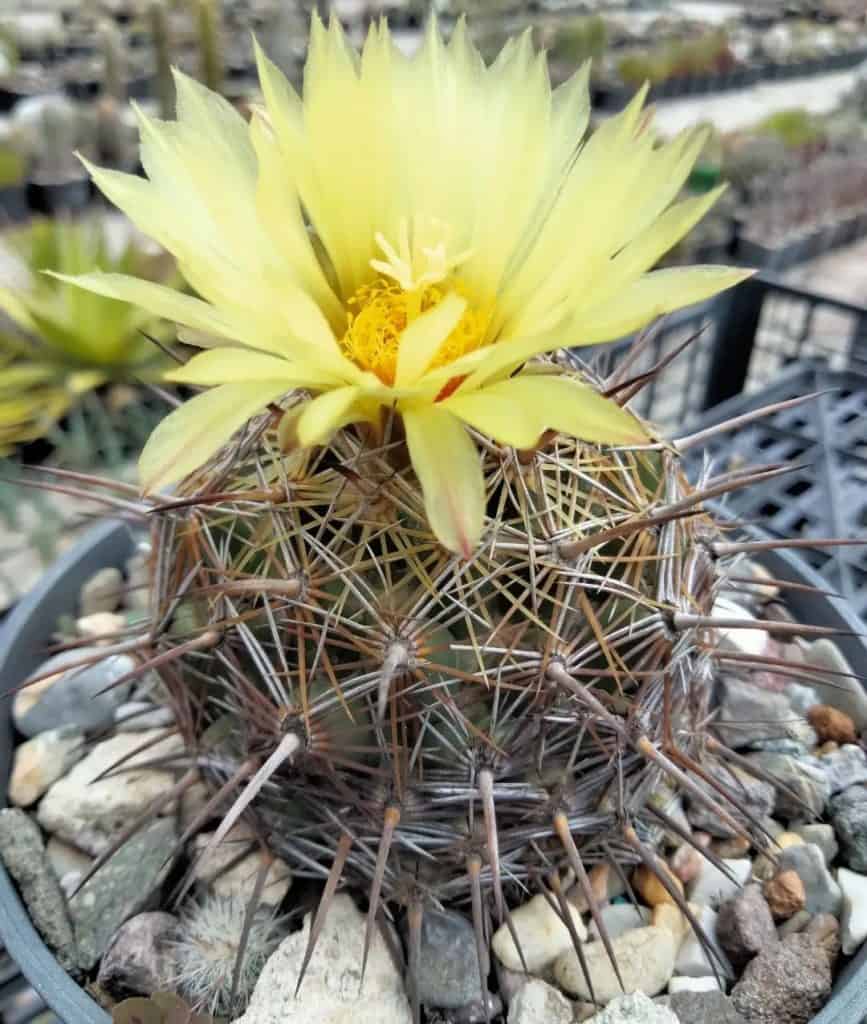Coryphantha cornifera: The Rockstar Cactus with Major Attitude
Get ready to meet the small but mighty Coryphantha cornifera – a cactus with some serious rock star vibes! This spiky little number is guaranteed to liven up any desert garden or sunny windowsill with its wild hairstyle of twisted spines radiating out in every direction.
While its bold exterior may look intense, C. cornifera’s vibrant yellow (or reddish) funnel-shaped flowers add a burst of color and flair. Clearly, this is one cactus that isn’t afraid to let its quirky personality shine through!

Contents
About Coryphantha cornifera
Native to the Mexican states of Querétaro and Hidalgo, C. cornifera is quite the variable species. It typically grows as a solitary, globular to cylindrical stem ranging from 3-6 inches in diameter and 2-5 inches tall. The dull olive-green body has a distinct blunt, depressed center that gives it an almost crown-like appearance covered in dense woolly fibers.
Adding to that cool structured look are the tubercles (nipple-like projections) that grow in spiral patterns of 5 and 8 ranks around the stem. Each tubercle is conical with a diamond-shaped base, slanted on top with a groove that may show some felt when the cactus is young.
But let’s get to C. cornifera’s most rockstar feature – the spines! The radial spines number between 10-20 and are colored in shades of whitish-yellow to horn-like, sometimes with darker tips. Ranging from 0.4-0.6 inches long, these spiky needles radiate outward horizontally in an awesome interwoven, patterned array. Then in the very center, you’ll find the headlining act – 0-3 stouter, longer central spines up to 0.7 inches long. These can vary from dark brown when young to grayish as they age, often bending dramatically for added flair. With its fringey crown, twisting spines, and stunning flowers, Coryphantha cornifera definitely has all the makings of a pint-sized succulent superstar!
Related Post:
1,000 Types of Cactus [With Pictures]
How to Care for Coryphantha cornifera
Light
Being a true desert native, C. cornifera thrives in full sun. Outdoors, plant it somewhere it will receive at least 6-8 hours of direct sunlight daily. Indoors, a sunny south-facing window is ideal. You can also use a grow light to supplement bright light if needed.
Water
Like most cacti, this species is drought-tolerant and doesn’t need frequent watering. Allow the soil to completely dry out before watering again, which may only be once a week or less in hot summer months. Overwatering leads to rot, so err on the side of underwatering.

Soil
C. cornifera requires very well-draining soil to prevent moisture buildup around the roots. A cactus/succulent soil mix amended with coarse sand, perlite or small gravel works perfectly. Choosing the right porous soil mix is key.
Fertilizer
Feed with a balanced cactus fertilizer in spring at the start of the growing season. Go easy as too much fertilizer can cause problems. A diluted application is typically sufficient.
Temperature and Humidity
This rockstar cactus can handle temporary temperatures down to around 20°F when dry, but thrives in warm desert conditions. Low humidity is preferred.
Pests and Problems
Keep an eye out for mealybugs or nematodes, though C. cornifera is fairly resistant overall. Rot from overwatering is the biggest issue – make sure the soil fully dries between waterings.

Pruning
No pruning needed for this low-maintenance beauty!
Potting and Repotting
Use a relatively shallow container with drainage holes to prevent waterlogged soil. Terra cotta pots are ideal. Only repot every 2-3 years to provide fresh succulent soil.
Propagating Coryphantha cornifera
The best way to propagate and multiply your prickly Coryphantha cornifera collection is by growing new plants from seeds.
When propagating C. cornifera from seed, the key is timing it right after the last winter frosts have passed. Here are the steps:
- Sow the seeds shallowly in a well-draining seed starting mix at the end of winter
- You can opt to first germinate the seeds by placing them on a moist seed-starting medium until they sprout roots and then pot them up
- Once the seedlings have developed their first few spines, transplant them into a grittier cactus/succulent soil mix
- Make sure the soil is kept just barely moist but never soggy to avoid rot
- Provide bright light once established, such as from a sunny window or grow lights
- Be patient – it can take 8-12 years for the young plants to reach their full, distinct cornifera appearance!
With a little TLC, propagating this bold, spiky species from seed allows you to watch its whole miraculous life cycle unfold. Creating your own little Coryphantha cornifera garden is extremely rewarding for the dedicated cactus grower.
